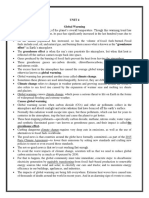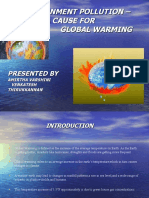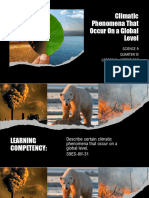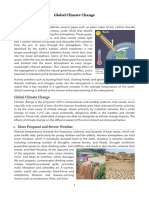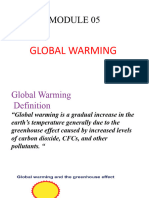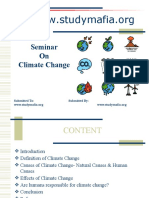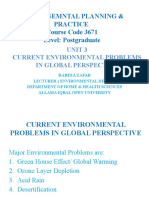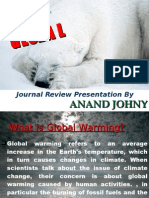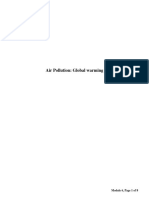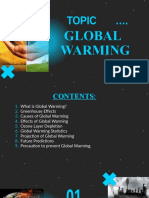0 ratings0% found this document useful (0 votes)
26 viewsGlobal Warming
Global Warming
Uploaded by
Ayushi jainGlobal warming is caused by increased greenhouse gases from human activities like burning fossil fuels and deforestation. It is leading to rising sea levels, stronger storms, worse droughts and wildfires, and effects on agriculture and human health. The document discusses the causes and many effects of global warming like melting glaciers and climate change.
Copyright:
© All Rights Reserved
Available Formats
Download as PDF, TXT or read online from Scribd
Global Warming
Global Warming
Uploaded by
Ayushi jain0 ratings0% found this document useful (0 votes)
26 views32 pagesGlobal warming is caused by increased greenhouse gases from human activities like burning fossil fuels and deforestation. It is leading to rising sea levels, stronger storms, worse droughts and wildfires, and effects on agriculture and human health. The document discusses the causes and many effects of global warming like melting glaciers and climate change.
Copyright
© © All Rights Reserved
Available Formats
PDF, TXT or read online from Scribd
Share this document
Did you find this document useful?
Is this content inappropriate?
Global warming is caused by increased greenhouse gases from human activities like burning fossil fuels and deforestation. It is leading to rising sea levels, stronger storms, worse droughts and wildfires, and effects on agriculture and human health. The document discusses the causes and many effects of global warming like melting glaciers and climate change.
Copyright:
© All Rights Reserved
Available Formats
Download as PDF, TXT or read online from Scribd
Download as pdf or txt
0 ratings0% found this document useful (0 votes)
26 views32 pagesGlobal Warming
Global Warming
Uploaded by
Ayushi jainGlobal warming is caused by increased greenhouse gases from human activities like burning fossil fuels and deforestation. It is leading to rising sea levels, stronger storms, worse droughts and wildfires, and effects on agriculture and human health. The document discusses the causes and many effects of global warming like melting glaciers and climate change.
Copyright:
© All Rights Reserved
Available Formats
Download as PDF, TXT or read online from Scribd
Download as pdf or txt
You are on page 1of 32
GLOBAL WARMING
Global Warming
Dr. Tariq Mahmood Usmani
Associate Professor
Definition
1. Global Warming is a gradual increase
in the overall temperature of the
earth's atmosphere generally attributed
to the greenhouse effect caused by
increased levels of carbon dioxide,
CFCs, and other Green house gases.
Definition
2. Global Warming is the increase of
Earth's average surface
temperature due to effect of
greenhouse gases, such as carbon
dioxide emissions from burning
fossil fuels or from deforestation,
which trap heat that would
otherwise escape from Earth.
Definition
3. Global Warming is
an increase in the earth's average
atmospheric temperature that
causes corresponding changes in climate
and that may result from the green
house effect.
Causes of Global Warming:
• The Earth maintains a habitable
temperature due to the Greenhouse
Effect, which allows heat from the sun to
penetrate our atmosphere, where it is
absorbed by the Earth’s surface or
radiated out and reflected back to Earth
by greenhouse gases in the atmosphere.
Without it, the Earth would be a cold and
hostile planet, and would most likely be
uninhabitable.
• However, maintaining the natural balance
necessary to keep the Earth’s temperature
within a range that is viable for life as we
know it is a very fine line that can easily
be crossed.
• Greenhouse gases are naturally occurring
gases that pose no harm when they are in
balance. However, when they are present
in excess, the system becomes unbalanced
and things start to go awry.
Anthropogenic Causes of Global
Warming
• The most important greenhouse gases
are carbon dioxide, methane, nitrous
oxide and water vapour. While all these
gases occur naturally in the atmosphere,
emissions from human sources have
caused their levels to rise to a point that is
no longer sustainable.
Carbon Dioxide
• Atmospheric carbon dioxide
concentrations have risen by more than
40% since scientists first started recording
these levels, from 280 parts per
million (ppm) in 1958 to over
400ppm today.
• According to NOAA, over the past 800,000 years, atmospheric carbon
dioxide concentrations have fluctuated between 180 ppm during ice
ages to 280 ppm during warm interglacial periods.
Human sources of Carbon Dioxide
• Burning Fossil Fuels: burning coal to generate electricity,
burning oil to power vehicles and aircraft (vehicle emissions),
or burning wood in fires used for cooking or to provide heat,
etc. changes the state of stored organic carbon from a liquid
(e.g. oil) or solid (e.g. coal/wood) into a gas (carbon dioxide)
which is released into the atmosphere.
• Deforestation: vegetation absorbs carbon dioxide from the
atmosphere during the process of photosynthesis, converting
this to carbon which is stored within all plants (i.e it is a
carbon sink). When vegetation is burned, this organic carbon
is released into the atmosphere in the form of carbon dioxide,
and in so doing becomes a carbon source rather than a carbon
sink.
Methane
• Although methane has a shorter
lifespan, and consequently, is not as
abundant in the atmosphere as carbon
dioxide, in terms of it effect as a
greenhouse gas, it is much more potent.
Methane is produced when organic
matter breaks down and also when
ruminants digest their food.
Human sources of Methane
• Decomposing organic matter: landfills, animal waste,
sewerage and dams are all human sources of methane.
For example, organic matter is trapped behind dam
walls where it sinks to the bottom of the dam and
decomposes. Bacteria produce methane in the
decomposition process, which slowly escapes to the
surface and is released into the atmosphere.
• Natural gas extraction: methane escapes during oil
and gas extraction (e.g. fracking) operations and is
released into the atmosphere.
Nitrous Oxide
• Nitrous oxide is a potent greenhouse gas
that is released primarily by
fertilizers used in agriculture and
landscaping, but also during the burning
of fossil fuels and other organic matter.
Atmospheric nitrous oxide levels have
risen by roughly 18% since the
Industrial Revolution, spiking rapidly
towards the end of the 1900’s.
Water Vapour
• Water is essential for life, and as it is constantly
cycling from one state to another, it is not
surprising that it is the most abundant of all the
greenhouse gases. However, water vapour not
only acts as a greenhouse gas, it also increases as
the atmosphere gets warmer and provides climate
feedbacks. While humans do not play a large
direct role in producing water vapour,
other human emissions promote atmospheric
warming, which in turn promote evaporation that
results in more water vapour in the atmosphere.
Chlorofluorocarbons
• Chlorofluorocarbons (CFCs) are long-
lasting greenhouse gases that also
destroy the ozone layer. CFCs do not
occur naturally in the atmosphere – they
are synthetic compounds that only
originate from human sources,
including: aerosols, foaming agents,
refrigerants, and other industrial
applications.
• CO2, methane and nitrous oxide
concentrations far exceed natural range
over past 650,000 years - most of the
increase has been post-industrial
revolution.
CO2 from 280 ppm to 380 ppm.
Methane from 715 ppb to 1775 ppb.
Nitrous oxide from 270 ppb to 320 ppb.
Increasing global CO2 emissions and changing
sources
Effects of Global Warming:
• 1. Melting Glaciers • 8. Heat waves
• 2. Climate Change • 9. Frequent Wildfires
• 3. Droughts • 10. Severe Precipitation
• 4. Disease • 11. Longer/Shorter
• 5. Hurricanes Frequency Season
• 6. Rise of Sea Levels • 12. Crops
• 7. Agriculture • 13. Oceans
• 14. Food Chain
Effects of Global Warming:
• 20. Decreased Population
• 15. Health Risk
• 21. Human Extinction
• 16. Animal Extinction
• 22. Going off Grid
• 17. Quality of Life
• 23. Fresh Water
• 18. Economic Collapse
• 24. Disappearing
• 19. Air Quality
Countries
What is Climate Change?
Climate change is the change in our weather
patterns that are occurring because of an
increase in the earth's average temperature.
It is also known as global warming.
Climate change may result from both natural
and human causes though the human causes
appear to be increasingly responsible for
climate change over the past few decades.
• 1. Melting of Glaciers: The melting of glaciers will
create plethora of problems for human kind and the
animals living on the earth. Due to increased global
warming, the level of the sea will rise which will lead to
flooding and this will in turn create havoc in human life.
Apart from raising the sea levels, it will also endanger
several species of animals and thus will hamper the
balance of the ecosystem.
• Areas in the Arctic are diminishing away and flowing
into major oceans. Rising temperatures create a much
accelerated threat to wildlife and whole ecosystems in
these regions. With glaciers melting at vast rates, a
chain of events is being set into motion that cannot be
reversed.
• 2. Climate Change: Irregular weather patterns have already
started showing results. Increased precipitation in the form of
rain has already been noticed in polar and sub-polar regions.
More global warming will lead to more evaporation which will
cause more rains. Animals and plants cannot easily adapt to
increased rainfall. Plants may die and animals may migrate to
other areas, which can cause entire ecosystem out of balance.
• 3. Droughts: While it may be flooding in Savannah, severe
drought is happening elsewhere in the world. As temperatures
warm, the presence of drought has increased in the western
U.S. Add on top of that heat waves and no precipitation; whole
forests have begun to disappear including tens of millions of
trees in Colorado’s Rockies.
Large scale evaporation will be the major cause of droughts
in many places particularly Africa. Although, it is reeling under
the huge pressure of water crisis, increased global warming
would further make the situation worse and will cause
malnutrition.
• 4. Diseases: As the temperature becomes more warmer, it
can affect the health of humans and the diseases they are
exposed to. With the increase in the rainfall, water borne
diseases are likely to spread like malaria. The earth will become
more warmer and as a result heat waves are likely to increase
that can cause a major blow to the people.
• 5. Hurricanes Frequency: As the temperature of the oceans
rises, hurricanes and other storms are likely to become stronger.
With the increase in the global warming, the water in the ocean
warms up and it heats up the surrounding air, creating
hurricanes.
• 6. Rise of Sea Levels: The melting of polar ice-caps and less
water evaporating into the atmosphere are causing increased
sea levels. Quaint coastal towns and cities near the U.S. east
coast and Gulf of Mexico are just a few areas where devastating
flood damage is starting to make its mark in history.
• 7. Agriculture: Global warming can affect agriculture.
Although the results are not visible yet, but it may show its
effects in years to come. As the global temperature will
increase, plants will find it harder to survive and will die.
Plants are the major source of food for human beings and as
a result food shortage may occur. The shortage of the
food may lead to war and conflicts in some countries.
• 8. Heat Waves: If you thought last summer’s headlines of
record changing temperature was mind blowing, just wait.
Because of greenhouse gases and other causes, unexpected
streaks of severe weather are just the tips of the iceberg in
global warming. Heat waves cause dangerously hot weather
and in recent years, more deaths have occurred due to heat
waves than in the last sixty years.
• 9. Frequent Wildfires: While wildfires are a natural occurrence, with
the added carbon dioxide in the air, and hotter summers, the
evidence speaks for itself. More frequent wildfires continue to
surface in vast amounts each year. The rate at which they burn is
longer than the last, and with the release of carbon dioxide into the
air, not only are people’s lives in danger, but wildlife severely
suffers. Each time a wildfire burns, the less oxygen there is to
combat the dangerous amounts of carbon dioxide being released
into the atmosphere.
• 10. Severe Precipitation: Not only is there insurmountable scientific
evidence that global warming is increasing, certain types of events,
including extreme precipitation is on the rise. Global warming also
creates conditions that can lead to more powerful hurricanes and
summer storms. Cities and towns on the coast, where sea levels are
already rising, face even more challenges as precipitation poses
severe flooding.
• 11. Longer/Shorter Seasons: Are you a lover of fall? Maybe
spring is your favourite season. Whatever weather and
climate you enjoy, it could be happening sooner and shorter,
or later and longer. Global warming affects show spring is
occurring 10 days sooner than it has in the past. While it may
be nice to go from snow pants to shorts sooner, this could
cause flooding from reservoirs filling too soon, and droughts
were there’s not enough precipitation to provide adequate
nourishment for crops.
• 12. Crops: If seasons are changing, weather patterns are
going berserk, and flooding is occurring due to rising sea
levels, our crops are barely getting a fighting chance. Once
the food processing industry goes haywire, the economy will
really start getting interesting. The price of staple crops could
sky rocket causing major inflation and more economic woes.
• 13. Oceans: It’s reported that coral reefs are continuing to
see diminished presence in the ocean due to global warming.
Temperature changes affect more than what’s happening on
our lands. Once coral reefs are affected, entire ecosystems
that thrive become obsolete.
• 14. Food Chain: Change the time and seasons and birds are
flying south for winter sooner, hibernation takes longer, and a
whole series of events is set in motion for complete collapse
of animal life. The entire food chain could be disrupted and
enormous consequences could follow.
• 15. Health Risks: As more carbon dioxide is trapped in the
atmosphere, breathable air becomes harder to come by. If
global warming continues, the U.S. is looking at 60 billion
dollars to combat respiratory diseases and symptoms.
• 16. Animal Extinction: Nature’s best is beautifully displayed
in every nook of planet earth-the majestic lion, to the humble
deer. Imagine whole populations where animals can no longer
thrive. With such a vast eruption in the animal kingdom, our
own world becomes in danger.
• 17. Quality of Life: If doing simple things like taking a walk
outside or working in your garden, become unenjoyable due
to severe heat waves, think of the quality of life on a much
larger scale. With rising global temperature, even the smallest
things we took for granted will be sorely missed.
• 18. Economic Collapse: Who knows how badly the economy
could get with decreased vitality of crops, productions, and
manufacturing items. Without having nature on our side, the
food industry will fall apart. Without the resources to feed the
world, manufacturing will collapse. Hunger will be our biggest
battle.
• 19. Air Quality: As more chain of events is set in motion, air
quality will continue to get worse. As bad as it is now in some areas
in the world, multiply that by a million.
• 20. Decreased Population: If global warming goes unchecked, it’s
estimated the world’s human population would decrease by 75
percent. With the increasing severity of storms, floods, earthquakes,
and wildfires, natural disasters would diminish half of the earth’s
population. Another 25 percent would succumb to air related
illnesses, starvation, and poverty.
• 21. Human Extinction: What little would remain of the earth as we
know it, would be a sliver. The rest of the human population would
have to find and implement alternative energy on a consistent and
regulated basis. It’s hard to imagine, but each of these events
affects another event. Pretty soon, the domino effect will reach
home. There’s plenty that can be done to guarantee these effects
won’t become earth’s ultimate fate
• 22. Going off the Grid: If you can’t stand to go
without power during a thunderstorm, imagine our
whole electrical infrastructure going off the grid. With
the current threat of increasing storms and violent
aftermaths of hurricanes and tropical storms, it would
only take a few hits to crumble our electrical system.
• 23. Fresh Water: Our fresh water supply will great
diminish with global warming. With the demise of coral
reefs and the ecosystems therein, less fresh water will
flow into lakes and tributaries.
• 24. Disappearing Countries: Countries like
Greenland are deteriorating at a highly elevated rate.
Beautiful cities, even continents could one day be part
of a vast sea.
Q1. Describe the concept of region. Divide the
world into natural region and give detail
description of equatorial region, temperate
region and polar region.
OR
Q2. Differentiate between Systematic (General)
Geography and Regional Geography.
OR
Q3. What is Global warming? How it is related to
the climate change.
You might also like
- 13 - The Mystery of Easter Island - An Ecology Case Study - Answer KeyDocument3 pages13 - The Mystery of Easter Island - An Ecology Case Study - Answer Keyaudio addictionNo ratings yet
- Biology Work Sheet For Grade 10 PDFDocument7 pagesBiology Work Sheet For Grade 10 PDFYishakNo ratings yet
- Draft EIS - Bayawan City River PDFDocument239 pagesDraft EIS - Bayawan City River PDFCassandra Kate MagabilinNo ratings yet
- CNR Module 5.1Document18 pagesCNR Module 5.1gaya3devi.2003bNo ratings yet
- Global Warming, Climate Change and Adjustment - PPTX - 16.04.19Document50 pagesGlobal Warming, Climate Change and Adjustment - PPTX - 16.04.19Samin AhmedNo ratings yet
- Unit 4Document13 pagesUnit 4Gamer BroNo ratings yet
- Global Warming PPT 1Document16 pagesGlobal Warming PPT 1Tech GyanNo ratings yet
- Global Warming: A Presentation BY Ragini SinghDocument17 pagesGlobal Warming: A Presentation BY Ragini Singhiriya singhNo ratings yet
- Environment Pollution - A Cause For Global WarmingDocument17 pagesEnvironment Pollution - A Cause For Global WarmingAnil SharmaNo ratings yet
- Climatic Phenomena That Occur On A Global Level: Science 9 Quarter Iii Lesson 5 - Weeks 6&7Document25 pagesClimatic Phenomena That Occur On A Global Level: Science 9 Quarter Iii Lesson 5 - Weeks 6&7jesterrodriguez79No ratings yet
- Greenhouse Effect: Global Climate ChangeDocument5 pagesGreenhouse Effect: Global Climate ChangeyskstogtyNo ratings yet
- Chapter 7Document17 pagesChapter 7wildinmaealbisNo ratings yet
- Global WarmingDocument4 pagesGlobal WarmingHassan AhmedNo ratings yet
- Global Warming: SiddharthaDocument19 pagesGlobal Warming: SiddharthaprincegirishNo ratings yet
- Lecture 3 and 4Document19 pagesLecture 3 and 4farihakanwal2021No ratings yet
- Module 5 CNRDocument41 pagesModule 5 CNRHarshith Kumar hvNo ratings yet
- Global Warming AssignmentDocument6 pagesGlobal Warming AssignmentMeenu MathurNo ratings yet
- 1 Unit: 6 Environmental Policies and PracticesDocument15 pages1 Unit: 6 Environmental Policies and PracticesSrividya SNo ratings yet
- What Is The Greenhouse Effect?Document50 pagesWhat Is The Greenhouse Effect?surajsingh0% (1)
- 1 Nature of CCDocument36 pages1 Nature of CCJayArt Amogis TemPoralNo ratings yet
- What Is Global WarmingDocument3 pagesWhat Is Global Warmingsamihahadj194No ratings yet
- Global Warming and Climate ChangeDocument26 pagesGlobal Warming and Climate ChangeHasna BabuNo ratings yet
- Global WarmingDocument7 pagesGlobal WarmingPoojaNo ratings yet
- Climate 3 Ref FinalDocument20 pagesClimate 3 Ref FinalAzhar HassanNo ratings yet
- Introduction To Climate Change (The Science of Climate Change)Document30 pagesIntroduction To Climate Change (The Science of Climate Change)enoch taclanNo ratings yet
- Global Warming Is The Current Increase in Temperature of The Earth's Surface (Both Land andDocument2 pagesGlobal Warming Is The Current Increase in Temperature of The Earth's Surface (Both Land andharinathNo ratings yet
- Report Contemporary WorldDocument3 pagesReport Contemporary WorldTapia, DarleenNo ratings yet
- Green House Effect and Global WarmingDocument26 pagesGreen House Effect and Global Warminganiruddhacha910No ratings yet
- Climate Change 2Document48 pagesClimate Change 2Awma PachuauNo ratings yet
- Climate ChangeDocument27 pagesClimate ChangeMahnoor Ch.100% (1)
- Climate-Change PPT1Document42 pagesClimate-Change PPT1Raida AdimNo ratings yet
- Unit 3-Lecture 3 - 12-08-17Document145 pagesUnit 3-Lecture 3 - 12-08-17M Hammad ManzoorNo ratings yet
- Part 1Document36 pagesPart 1shimaa.ashraf8408No ratings yet
- Climate Change and Energy CrisisDocument9 pagesClimate Change and Energy CrisiscastrohelaenadaphnieNo ratings yet
- Global Warming and How It Is Affecting Life on EarthDocument4 pagesGlobal Warming and How It Is Affecting Life on EarthZulaiha ZakariaNo ratings yet
- Unit 5Document25 pagesUnit 5A BhNo ratings yet
- Climate ChangeDocument41 pagesClimate Changerkadyan1467No ratings yet
- Global Environmental Issues - CompressedDocument144 pagesGlobal Environmental Issues - Compressedvigici2555No ratings yet
- Global WarmingDocument11 pagesGlobal Warmingghataksampa816No ratings yet
- Global Climate ChangeDocument71 pagesGlobal Climate ChangeLemlem ArgawNo ratings yet
- EVS OriginalDocument5 pagesEVS Originalkhandareshobhit17No ratings yet
- Global Warming1Document7 pagesGlobal Warming1nitinlawandeNo ratings yet
- GEO RESUMEN!!!!!Document6 pagesGEO RESUMEN!!!!!cami.nu07No ratings yet
- Globa L Warm INGDocument25 pagesGloba L Warm INGanandjohnyNo ratings yet
- Our ProjectDocument22 pagesOur ProjectMhmoud AhmedNo ratings yet
- It's Gettin' Hot in Here!Document28 pagesIt's Gettin' Hot in Here!Dipanjan DasNo ratings yet
- Why Does The Average Temperature of The Atmosphere RiseDocument2 pagesWhy Does The Average Temperature of The Atmosphere RisecfundanNo ratings yet
- Global WarmingDocument8 pagesGlobal WarmingMhmoud AhmedNo ratings yet
- Global Warming 10 Pages InformationDocument10 pagesGlobal Warming 10 Pages InformationJasvinder Singh100% (4)
- Unit 4Document28 pagesUnit 4Vaishali JoshiNo ratings yet
- Module 4-Climate Change and Energy Crisis... STSDocument31 pagesModule 4-Climate Change and Energy Crisis... STSaljon.tolete.pbsNo ratings yet
- Unit 4Document28 pagesUnit 4Mohd NomaanNo ratings yet
- Ict Microproject (351-355)Document22 pagesIct Microproject (351-355)2717 Pushkar YadavNo ratings yet
- Final Global WarmingDocument24 pagesFinal Global WarmingEllyn Marie PerezNo ratings yet
- CLIMATE CHANGE (1)Document42 pagesCLIMATE CHANGE (1)meenavandana336No ratings yet
- Greenhouse Effect and Global WarmingDocument15 pagesGreenhouse Effect and Global WarmingVarun BakshiNo ratings yet
- Lesson-11 GE 3Document13 pagesLesson-11 GE 3Rhea llyn BacquialNo ratings yet
- Unit 5Document31 pagesUnit 5Ananya PandeyNo ratings yet
- Global WarmingDocument11 pagesGlobal WarmingNader Morris100% (1)
- English Project Class 12Document17 pagesEnglish Project Class 12sharvari shendeNo ratings yet
- Lec 6 Climate Change#1Document32 pagesLec 6 Climate Change#1Zoro ZoroNo ratings yet
- What is Global WarmingDocument6 pagesWhat is Global WarmingB.Rethesh Kumar reddy VII gradeNo ratings yet
- Difference Between Weather and ClimateDocument3 pagesDifference Between Weather and ClimateAyushi jainNo ratings yet
- 15 Irreducibility and Extensions: Unit FieldDocument11 pages15 Irreducibility and Extensions: Unit FieldAyushi jainNo ratings yet
- Course Structure & Syllabi: B.A./B.Sc. (Honours) (Mathematics) (Main & Subsidiary)Document29 pagesCourse Structure & Syllabi: B.A./B.Sc. (Honours) (Mathematics) (Main & Subsidiary)Ayushi jainNo ratings yet
- Annexure-183. (BA Prog - Education) (REVISED)Document38 pagesAnnexure-183. (BA Prog - Education) (REVISED)Ayushi jainNo ratings yet
- Reliability Theory and Survival Analysis FinalDocument12 pagesReliability Theory and Survival Analysis FinalAyushi jainNo ratings yet
- Edristi Navatra June 2021Document221 pagesEdristi Navatra June 2021Ayushi jainNo ratings yet
- Gri 306 Waste 2020Document28 pagesGri 306 Waste 2020nrs_bbsrNo ratings yet
- Mã học phần: - Số tín chỉ (hoặc đvht) : Lớp: Họ, tên thí sinh:..................................................................... Mã sinh viên: ............................Document2 pagesMã học phần: - Số tín chỉ (hoặc đvht) : Lớp: Họ, tên thí sinh:..................................................................... Mã sinh viên: ............................documentclassa7No ratings yet
- Septic Tank Standard PHDocument2 pagesSeptic Tank Standard PHKenneth D. PacadaNo ratings yet
- Module 1 - Understanding Environmental EducationDocument27 pagesModule 1 - Understanding Environmental Educationmichelle joy nangitNo ratings yet
- Wondrous Worlds PDFDocument15 pagesWondrous Worlds PDFSalvadorNo ratings yet
- SAG - Agricultural Crop Production NC IIDocument5 pagesSAG - Agricultural Crop Production NC IIDanny R. SalvadorNo ratings yet
- R N R I D I: OLE OF Atural Esources N Evelopment OF NdiaDocument43 pagesR N R I D I: OLE OF Atural Esources N Evelopment OF NdiaAkhil VermaNo ratings yet
- Of Vertical Farming (Indoor) Over Traditional Farming (Outdoor)Document30 pagesOf Vertical Farming (Indoor) Over Traditional Farming (Outdoor)Sneha Periwal100% (1)
- GIZ-Land Use Planning Manual - EngDocument236 pagesGIZ-Land Use Planning Manual - EngAbdiket Kumsa GudetaNo ratings yet
- 26 Environmental ProtectionDocument2 pages26 Environmental ProtectionВалерия МоскаленкоNo ratings yet
- Research Paper On Green EntrepreneurshipDocument11 pagesResearch Paper On Green EntrepreneurshipKanishka SharmaNo ratings yet
- A Shifting LandscapeDocument7 pagesA Shifting LandscapeDenison CordovaNo ratings yet
- A50 CS100Document4 pagesA50 CS100Kylah AtunNo ratings yet
- Test KL 8 3 Mujori I 2 Grupi ADocument2 pagesTest KL 8 3 Mujori I 2 Grupi Aesmeraldakara2No ratings yet
- El Niño Modoki Dan Pengaruhnya Terhadap Perilaku Curah Hujan Monsunal Di IndonesiaDocument62 pagesEl Niño Modoki Dan Pengaruhnya Terhadap Perilaku Curah Hujan Monsunal Di IndonesiaSarNo ratings yet
- 2.2 Nutrient Cycle in An EcosystemDocument13 pages2.2 Nutrient Cycle in An EcosystemYu Xuan ChongNo ratings yet
- MPCC Case StudyDocument47 pagesMPCC Case StudyAbhinav SrivastavaNo ratings yet
- Yamuna Action Plan: A Bilateral Project of Government of India & Japan On River ConservationDocument6 pagesYamuna Action Plan: A Bilateral Project of Government of India & Japan On River ConservationNamrata PCNo ratings yet
- Presentation On Water Resources of Nepal: Presented By: Subin Shrestha BSC - IT (NP000357)Document20 pagesPresentation On Water Resources of Nepal: Presented By: Subin Shrestha BSC - IT (NP000357)Narayan TimilsainaNo ratings yet
- M.SC Env. Sci SyllabusDocument22 pagesM.SC Env. Sci SyllabusbmintegNo ratings yet
- Lecture Notes - Evs Unit - 3Document20 pagesLecture Notes - Evs Unit - 3Nambi Rajan100% (1)
- Capstone DocumentDocument51 pagesCapstone DocumentJoe ComerNo ratings yet
- Development of A Simulation-Based Decision Support Workflow For The Implementation of Building-Integrated Agriculture (BIA) in Urban ContextsDocument14 pagesDevelopment of A Simulation-Based Decision Support Workflow For The Implementation of Building-Integrated Agriculture (BIA) in Urban ContextshgordonsmithNo ratings yet
- Central AravaDocument31 pagesCentral Aravadonhan91No ratings yet
- Wheat Production in FranceDocument27 pagesWheat Production in Franceapi-299764600No ratings yet
- Topics in Sustainable-Building Science: - Course SyllabusDocument5 pagesTopics in Sustainable-Building Science: - Course SyllabuspikermiNo ratings yet
- Weather: Questions: What Is Your Favorite Kind of Weather? Why?Document2 pagesWeather: Questions: What Is Your Favorite Kind of Weather? Why?nhi100% (1)





